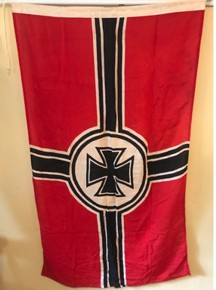 image by David Barnhill
image by David Barnhill
Last modified: 2024-10-05 by martin karner
Keywords: germany | fictitious flags | wirmer | resistance | federal state | bundesland |
Links: FOTW homepage |
search |
disclaimer and copyright |
write us |
mirrors
"A fictitious flag is a flag – or the illustration of a flag – that purports to
represent an actual entity or person, but for which no evidence of any such use by that entity or person
exists – a pseudo, spurious or surrogate flag"
(Dictionary of Vexillology).
These flags are not to be confused with "fictional flags" or
"unidentified flags" (UFE).
They aren't mere illustrations; they do exist in the real world, they give the appearance
of being historical, and their creators are quite clear aobut their intentions.
I am a relatively new collector of militaria from the WWI/WWII periods, mostly in flags. I am attaching
a photo of a flag that allegedly is from the Nazi era, maybe post era. The claim is that it is possibly a
Nazi Army veteran/Iron Cross recipient flag. Or, It could just be a fantasy flag. Do you have any
knowledge about this flag, or do you know of anyone who might?
David Barnhill, 19 January 2022
This is not a historic flag at all, but one of modern manufacture. It is based on a fictional Fourth
Reich that is part of the Alternate History Wiki website
for its Fandom. It appears to be a rip-off fantasy flag based on the real historical "German War
Ensign of the Third Reich" used between 1935–1945 but this modern flag was never a real historical
flag.
As a point of reference for those collecting Third Reich flags, the use of metal grommets was not a common
practice used by German flag manufacturers during the NSDAP era. German World War II era flags in general
usually had a rope sewn to the bunting with no heading, although some had a canvas heading with the rope
sewn in, and if they did have hand-worked steel grommets they normally looked more like buttonholes.
Those with hand-worked grommets could have metal or leather pieces under the stitching to reinforce the
material. Many Military flags commonly had a sleeve through which a pole could be passed, or they might
even have a series of hand-worked buttonholes that were then lashed individually to the pole. Almost all
metal grommets used on flags after about 1890 were brass except in places where a shortage of brass
developed during World War II (1942–44). The point of this is, it appears that the grommets on your
flag appear to be of modern manufacture and not made of steel or brass at all.
Pete Loeser, 2 February 2022
See also: Fictional Flags similar to the flag of Nazi Germany
A German flag seller created this fictitious German Resistance War Flag and offers it on
his webshop. It has been derived from Josef Wirmer’s
"Resistance Flag" from 1944. If the German resistance movement
in World War II would have created an state of its own, its war ensign probably would have looked like
this. On a red field a black cross offset to the hoist, fimbriated yellow and black with in its middle
a yellow disc with the black eagle, and a black-red-gold flag with a black Iron Cross in the canton.
This version has the federal eagle with its heraldic clear and unfussy design.
The flag is also available with three other versions of eagles (same colours): Prussia,
the Kaiserreich and the Weimar Republic.
Martin Karner, 21 January 2023
See also: Proposals 1944–1949 (Germany)
Black, Red and Gold: The Genesis of Germany's National Colours (by Arnold Rabbow, ICV 22, 2007)
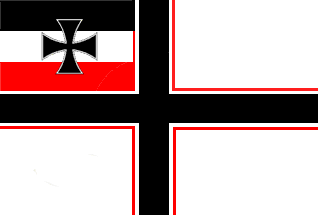 image by Pete Loeser, 14 March 2010
image by Pete Loeser, 14 March 2010
In Germany in particular there exist a great number of "fictitious flags" that have been
manufactured to look similar to real historical German flags but did not in fact exist historically.
Their designs are fictional, but the flags exist in the real world. They are usually manufactured for
profit in hopes they will fit a need or become widely used. They reside in tourist stores, are sold on
the streets, in flag shops, flea markets or on the internet. They are also very popular with extremist
groups in Germany because the German government has made it illegal to display actual historical
National Socialist flags and ensigns, so look-a-like flags are used. A great example of this would be
the False Imperial War Ensign that was originally displayed at the German reunification celebrations
in 1990, but never existed before that. Find out more about this at
False War Ensign 1990 where it was first reported on FOTW.
Pete Loeser, 23 January 2023
See also: Re-purposed Historical German Flags by Modern German neo-Nazi Extremist Groups
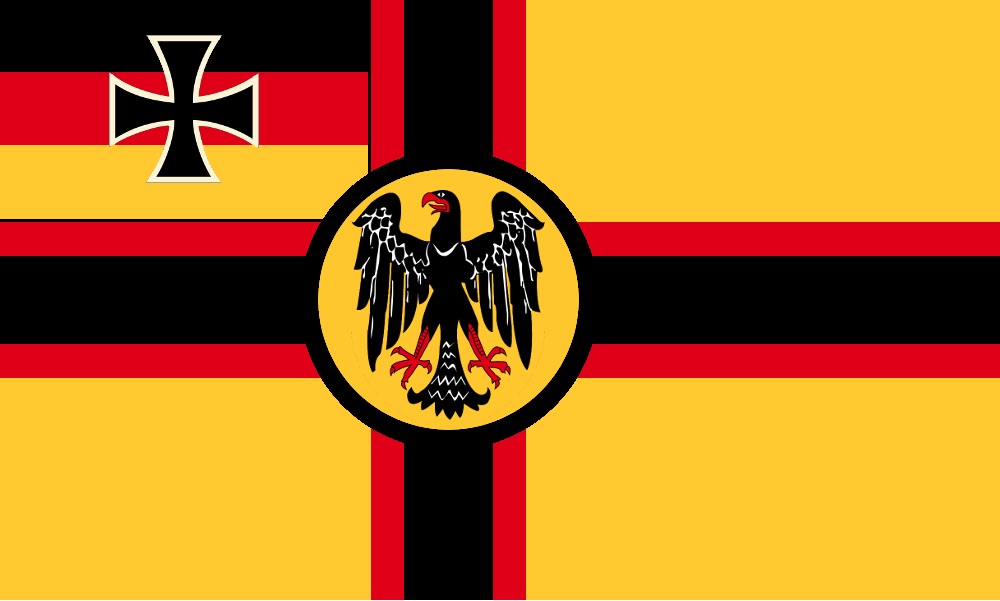
 images located by Martin Karner
images located by Martin Karner
On ebay a fictitious German war flag ("Kriegsflagge")
is offered (right picture above). Beside "Kriegsflagge" it is also labeled falsely as flag of the "Deutsche Legion". It is derived
from the adopted but not used War Ensign of 1919,
with a yellow instead of a white field.
The alternative history site Alternativgeschichte-Wiki
(based on fantasy) describes this flag as a derivation of the flag of the likewise fictional
Deutsche Legion (Neunorwegen) (German Legion (New Norway)), a German troop
unit of German emigrants in "Neunorwegen" (New Norway) and "New Norwegians" of German origin during WW2
(picture Deutsche Legion flag). The Federal War Flag
(Bundeskriegsflagge) is said to have been adopted on 23 May 1946.
Martin Karner, 24 April 2023
Actually, those German emigrants were not in Norway (Norwegen), but
in New Norway (Neunorwegen), a fictional country which was founded
in Patagonia by immigrants from Norway in 1835: https://althistory.fandom.com/de/wiki/Neunorwegen_(Neunorwegen).
The unit in question is said to have been under command of a German
government (Weimar Republic) in exile, residing in New York.
Tomislav Todorovic, 26 April 2023
See also: Colour for Armed Forces Units (Germany)
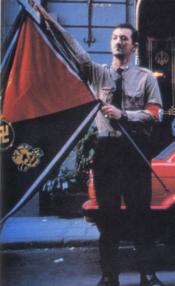 image located by Esteban Rivera, 11 June 2005
image located by Esteban Rivera, 11 June 2005
I'm enclosing a picture I found in a Colombian magazine called CAMBIO (http://www.cambio.com.co).
If someone knows the origin or could draw it, it would be very helpful.
Esteban Rivera, 11 June 2005
This flag shown would appear to be based on some sort of NASDP command flag such as these on our page on
SS command and other car flags. With the presence of the "Death Head",
could it be linked to a waffen-SS or SS-Totenkopfverbände unit? Alternatively, since the image is
modern (based on the car seen behind the man) could it be a fantasy item that simply recycled a few
elements?
Marc Pasquin, 30 July 2005
I found this website today that features the same flag (http://www.pzg.biz/flags_nazi.htm [restricted access]). If you scroll down this page you will find the title "SS Totenkopf Nazi Flags". At first sight it seems like a replica flag, but I doubt that.
Esteban Rivera, 4 December 2005
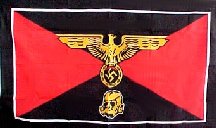 image by Pete Loeser, 23 May 2010
image by Pete Loeser, 23 May 2010
This flag has been widely distributed, and claims to have been the flag of the SS-Totenkompf Division, but no real creditable documentation exists to back the claim. The unit was, however, very real. The 3rd SS Division (one of approximately 38 divisions fielded by the Waffen-SS during World War II) was formed from the Totenkopf units that took part in the Polish Campaign. It should be noted that although this unit is sometimes called Polish, once again, there were no Poles in the ranks of SS-Totenkompf. The unit served both in France and on the Eastern Front. The Division surrendered to the Americans on May 9, 1945, and the prisoners were handed over to the Soviets. This particular modern replica of the Totenkopf Flag design seems to be based on a square unit patch or crest. Another similar modern version of this flag follows the same pattern, but doesn't have the skull. The embarrassing part of all this is, in my early enthusiastic years of vexillology, I wrote the flawed and mistaken description still being used by the PZG website and others. Some friendly help from Brian Davis later set me straight, but my early mistake has been embraced by those wishing this flag to be authentic, and it has taken on a life of its own.
Pete Loeser, 23 May 2010